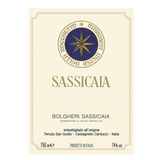- CRITICAL REVIEWS
- WINEMAKER NOTES
Robert Parker Wine Advocate
Vinous
2008 Tenuta San Guido Sassicaia Bolgheri, Tuscany, Italy
Appellation: D.O.C. Bolgheri Sassicaia
First vintage: 1968
Grape blend: 85 % Cabernet Sauvignon 15 % Cabernet Franc
Soil composition: The vineyards are planted on plots of land with different and composite morphological characteristics, as well as with a strong presence of limestone. These areas are also rich in rocks and rather rich in clay and are located at an altitudebetween 100 and 300 meters above sea level, facing West - South/West.
Vine training: Cordon spur system
Planting density: Between 3.600 to 5.500 vine stocks/Ha for older vineyards and 6.200 vine stocks/Ha for newer vineyards.
Climate: The 2008 sassicaia winter season was relatively mild and not particularly rainy except for some sporadic rainfall during the month of January; the temperatures fell around the middle of March, remaining below the seasonal average for around three weeks. This meant that plant growth was delayed by about 10 days compared to normal, having repercussions on the subsequent phenological phases (blossoming and veraison). Spring was very sunny but from 10th to 20th May, which corresponds to the blossoming period, there was frequent rain and a considerable drop in the temperature. This lead to low yield with few bunches of grapes on each plant and an overall lower production that has been certified at around 20% less than normal. After the May showers the summer season was fairly settled, apart an unusually hot period (about 2 weeks) between the end of August and the first 15 days of September. The course of ripening was standard for all the varieties however the grape harvest periods were very close together.
Harvest: Given the propitious climatic conditions, the harvest was carried out as usual and without any particular adjustments, beginning in the first ten days of September and ending during the first week of October.
Wine making: The primary fermentation took place in temperature controlled stainless steel vats at a temperature of 30° - 31° C. The maceration of the skins lasted 15 days for both the Cabernet Sauvignon and the Cabernet Franc, with a combination of pumping over and délestage. The malolactic or secondary fermentation also took place in the steel vats.
Ageing: The wine is aged for 24 months in French oak barriques and a few more months in the bottle before being released on the market.










